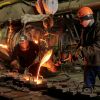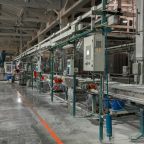
Managing Global Supply Chains in Casting: Challenges and Solutions for Manufacturers
Global supply chains have become more complex, interconnected, and risky than ever—especially for manufacturers in the casting industry. From sourcing delays to rising costs, every challenge affects production quality and delivery timelines. This guest post explores the biggest supply chain issues in casting and offers practical, future-ready solutions to strengthen resilience and efficiency.
Managing global supply chains has become one of the most demanding responsibilities for casting manufacturers. Expanding international markets, new materials, and rising customer expectations have pushed companies to adopt more innovative supply chain strategies. At the same time, disruptions—ranging from logistical delays to raw material shortages—have made it vital for manufacturers to strengthen every step of the process.
For those working with processes like Investment Casting, precision, timing, and consistency are critical. Any weak link in the supply chain directly impacts product quality, lead times, and customer satisfaction.
This article examines the key challenges facing global supply chains in casting and highlights effective, industry-relevant solutions for manufacturers seeking stability and long-term growth.
Why Global Supply Chains Matter in Casting
Casting manufacturers rely on a vast network of suppliers, transport partners, material processors, toolmakers, and customers across several countries. This global scope offers advantages such as:
-
Access to high-grade raw materials
-
Specialised tooling expertise
-
Cost-efficient production hubs
-
Opportunities to serve worldwide markets
However, it also introduces vulnerabilities. When even one part of the chain slows down, everything from mould creation to final casting delivery is affected.
Key Challenges in Managing Global Casting Supply Chains
1. Raw Material Shortages and Pricing Volatility
Steel, aluminium, nickel, and other casting alloys are often sourced from multiple countries. Market fluctuations, mining disruptions, and geopolitical tensions can reduce availability and push prices up.
Manufacturers face increased production costs, unpredictable lead times, and difficulty planning future output.
2. Logistics Delays and Rising Transportation Costs
International shipping is one of the biggest pain points today. Port congestion, limited container availability, increased fuel prices, and customs delays slow down material flow.
For casting businesses—especially those depending on precise timelines—late deliveries can halt production entirely.
3. Quality Control Across Borders
Ensuring consistent quality is challenging when multiple suppliers and countries are involved. Differences in standards, inspection practices, and documentation can introduce errors.
This issue is particularly significant in precision-focused processes like Investment Casting, where even small deviations affect final performance.
4. Dependence on Single-Source Suppliers
While single sourcing may appear cost-effective, it creates major risks. If the supplier faces shutdowns, strikes, or regulatory issues, production can collapse.
Casting manufacturers who rely on unique alloys, specialised moulds, or niche tooling are especially affected.
5. Limited Digital Visibility and Tracking
Many casting supply chains still operate with manual tracking and outdated spreadsheets.
This lack of transparency makes it difficult to monitor shipments, anticipate delays, and respond to disruptions before they escalate.
6. Global Compliance and Certification Requirements
Casting manufacturers supplying the aerospace, automotive, and medical industries must meet strict certifications.
Navigating different compliance frameworks across countries requires time, training, and sophisticated documentation management.
Practical Solutions for Strengthening Casting Supply Chains
1. Supplier Diversification and Multi-Region Sourcing
Relying on multiple suppliers across different regions significantly reduces risk.
By avoiding dependence on one country or one vendor, manufacturers benefit from:
-
Better pricing flexibility
-
More resilient material flow
-
Reduced downtime during unexpected disruptions
A multi-region strategy creates a safety net that keeps operations running smoothly.
2. Investing in Digital Supply Chain Tools
Modern supply chains depend on real-time visibility.
Technologies such as:
-
IoT tracking
-
Cloud-based logistics platforms
-
AI-driven forecasting
-
Automated documentation systems
These tools help manufacturers monitor inventory, track shipments, and predict disruptions before they affect production.
3. Stronger Supplier Partnerships and Long-Term Contracts
Building collaborative, long-standing relationships with suppliers ensures better communication and reliability.
Manufacturers benefit from:
-
Priority deliveries
-
Consistent pricing
-
Better quality alignment
-
Shared investments in materials and innovation
Stable partnerships often reduce operational risk by improving trust and transparency.
4. Implementing Global Quality Assurance Frameworks
Standardised inspection procedures, shared digital quality reports, and cross-border audits help maintain consistency.
Manufacturers producing high-precision components—such as those made using Investment Casting—can ensure tighter tolerances and fewer production errors.
5. Strategic Inventory and Safety Stock Planning
While lean manufacturing reduces waste, global supply chain risks require smarter stock planning.
Maintaining controlled safety stock of raw materials, tooling, and essential components prevents costly delays during supply shortages.
6. Using Predictive Analytics for Demand and Material Forecasting
Predictive tools help manufacturers anticipate:
-
Seasonal demand
-
Market price changes
-
Supplier performance patterns
-
Equipment maintenance needs
This data-driven approach improves purchasing accuracy and stabilises long-term production planning.
7. Strengthening Localisation and Near-Shoring Strategies
Many manufacturers are now shifting parts of their supply chain closer to their production base.
Near-shoring reduces:
-
Shipping costs
-
Lead times
-
Customs delays
-
Risk exposure
A hybrid model, global plus local sourcing, offers both cost benefit and reliability.
Emerging Trends Shaping the Future of Casting Supply Chains
Greater Digital Integration
Digital twins, smart foundries, and automated inspection systems will soon become standard across casting operations.
Sustainable Sourcing Practices
Manufacturers are increasingly adopting cleaner processes and recycled materials to reduce environmental impact.
Blockchain for Traceability
Blockchain will enhance transparency by providing tamper-proof records of materials, shipments, and certifications.
AI-Driven Quality Management
AI is already improving pattern correction, mould monitoring, and surface defect detection, especially in precision processes.
Conclusion
Managing global supply chains in the casting industry requires a combination of strategic planning, digital innovation, and smart supplier management. With rising pressures on logistics, pricing, and quality expectations, manufacturers must embrace resilience and flexibility.
By diversifying suppliers, adopting advanced tracking tools, reinforcing quality control, and building future-ready operations, casting manufacturers can remain competitive—even in a volatile global environment.
A well-managed supply chain is not just a support system—it is a strategic advantage that shapes long-term success and product excellence.

















